Anatomy of the Spine
The spine also called the backbone, is made up of vertebral bones with cushioning intervertebral discs between them. The spine is designed to give us stability and smooth movement, as well as providing a corridor of protection for the delicate spinal cord. It is supported by muscles, tendons, and ligaments, and innervated by nerves that branch out from the centrally placed spinal cord.
Having a well-functioning healthy back is essential for our mobility and ability to participate in various activities. Understanding the anatomy of the spine enhances your ability to discuss conditions of the spine and treatment options with your doctor.
Vertebra: The spine is made up of bony segments called vertebrae, and fibrous tissue called intervertebral discs. The vertebrae and discs form a column from your head to your pelvis providing symmetry and movement to the body.
This spinal column is made up of approximately 33 vertebral bones stacked one on top of the other from the base of the skull to the pelvis. Twenty-four of these vertebrae articulate with each other, while the last nine are fused together. Each vertebra is made up of several parts:
Vertebral Body: This is the main part of the vertebra. It supports most of the load while standing and provides a platform for the attachment of the intervertebral discs.
Pedicles: These are two cylinder-shaped projections originating from the back of the vertebral body, connecting the front and back of the vertebra.
Lamina: Lamina is a pair of flat arched bones that form the roof of the spinal canal and provide support and protection to the spinal cord at the back.
Spinous Processes: These are the bony projections that arise at right angles to the midline of the lamina. These projections can be felt when touching the back.
Transverse Processes: These are bony protrusions located at the junction of the pedicle and lamina. They provide a place for the attachment of the back muscles.
Spinal Canal: This is the tunnel formed at the center of the vertebra for the passage of the spinal cord.
Facet Joints: These are paired articular processes found at the vertebral arch. Each vertebra consists of two pairs of facet joints; one pair called superior facets articulates with the vertebra above and the other pair, inferior facets articulates with the vertebra below.
Intervertebral Discs: The intervertebral discs are flat, rounded soft tissue structures situated between two vertebral bodies of the spine. The discs are composed of a tough, fibrous outer ring called the annulus fibrous and a soft, inner core called the nucleus pulposus. Intervertebral discs function as shock absorbers for the spine. Aging and injury can cause degeneration of these discs and cause painful rubbing of the vertebral bones.
Vertebral Column: The vertebrae are arranged one on top of the other to form the spine. The spine is categorized into 5 spinal segments: cervical, thoracic, lumbar, sacral, and coccyx.
- Cervical: The cervical spine is called the neck. It begins at the base of the skull and is comprised of seven vertebrae numbered C1 to C7. The neck supports the weight of the head and allows the greatest range of motion due to two specially shaped vertebrae, the ring-shaped atlas and the peg-shaped axis, which are the first two vertebrae.
- Thoracic: The thoracic spine is made up of twelve thoracic vertebrae, which are numbered T1 to T12. They start from the upper chest and extend to the middle back, communicating with the ribs in the front of the chest to protect the heart and lungs.
- Lumbar: The Lumbar spine is made up of five lumbar vertebras numbered L1 to L5. These are situated in the lower back region and are larger in size. The major function of the lumbar vertebrae is to carry the weight of the body and absorb the stress of lifting and carrying heavy objects.
- Sacrum: The sacrum is a single bone, formed by the fusion of five sacral vertebras together. It connects the spine to the hip bones.
- Coccyx: Also called the tailbone, the coccyx is formed from the fusion of four bones and provides attachment for muscles and ligaments to the pelvic floor.
Spinal Curves: The side view of an adult spine resembles a natural S-shaped curve. The curves provide strength and support to the spine, maintain balance, and absorb shock. Any abnormality in the spinal alignment is called a spinal deformity.
Muscles: The most important spinal muscles include the extensors, flexors, and oblique muscles, which work to stabilize the spine and allow the spine to move. Any weakness or strain in the back muscles can cause incredible strain on the spine.
- The extensor muscles are attached to the back of the spine and help us to stand and lift objects.
- The flexor muscles originate from the front of the spine and include the muscles of the abdomen. These help in the forward movement and lifting and control the arch of the lower back.
- The oblique muscles are found at the sides of the body and help in the side-ways rotation of the back.
Ligaments: Spinal ligaments are strong fibrous bands that stabilize and hold the vertebrae in place. The major ligaments are the ligamentum flavum, anterior longitudinal ligament, and posterior longitudinal ligament. The anterior and posterior longitudinal ligaments are continuous bands that run from the top to the bottom of the spinal column along with the vertebral bodies, and the ligamentum flavum attaches one lamina to the other. These ligaments function to maintain the alignment of the vertebrae.
Spinal Cord: The spinal cord originates from the brain and extends through the base of the skull to the lower back through the spinal canal. It is covered by three membranes called meninges. Spaces between these membranes are filled with cerebrospinal fluid.
There are 31 pairs of spinal nerves that originate from the spinal cord. These nerves carry all the information from the body to the brain, controlling sensation and movement.
Any damage or injury to the spinal cord can cause loss of sensation or function to the part of the body that the nerves supply.
The spine is a complex anatomical structure made up of bones, joints, tendons, ligaments, muscles, nerves, and the spinal cord. This strong spinal column provides the basic structure, support, and flexibility to the human body.
Spine Conditions

Back Pain
Back pain or backache is the pain felt in the back that may originate from damage to the muscles, nerves, bones, joints or other structures in the spine. Back pain is one of the most common medical problems experienced by most people at some time in their life. It can be acute, usually lasting from a few days to a few weeks, or chronic, lasting for more than three months.

Cervicogenic Headache
Cervicogenic headaches involve pain in one or both sides of your head that radiates from your neck to the front of the head.
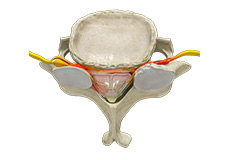
Cervical Stenosis
Cervical stenosis refers to the narrowing of the spinal canal that protects the spinal cord and its branching nerves.
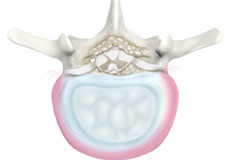
Degenerative Disc Disease
Degenerative disc disease (DDD) refers to the gradual deterioration of the intervertebral discs between the vertebrae. DDD is a misnomer as it is not actually a disease but a condition that affects the strength, resilience and structural integrity of the intervertebral discs due to advancing age, trauma, injury, repetitive movement, improper posture or poor body mechanics. DDD is commonly seen in individuals over 50 years of age.
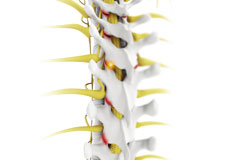
Facet Joint Arthritis
Facet joint arthritis, also known as facet joint syndrome, is a form of arthritis that affects the facet joints of the spine. This condition is related to the aging process.
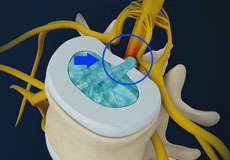
Disc Herniation
Disc herniation is a condition where the central nucleus pushes through the outer edge of the disc, causing a bulge that compresses the spinal nerves.
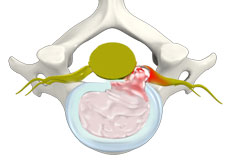
Herniated Disc (Cervical)
Herniation of a disc is an anomalous spine condition characterized by leakage of the inner contents of the intervertebral disc, due to cracks in its outer wall. A herniated disc is commonly seen in the cervical or neck region, a condition called cervical herniated disc (CHD).

Low Back Pain
Low back pain is often a common symptom of many disease conditions and the back pain may range from simple or dull pain to sudden and sharp pain. If the pain persists for a few days, it is acute pain whereas if it continues for more than 3 months, it is considered as chronic pain. In most cases, low back pain may resolve without any treatment, however, if it persists for more than 3 days, medical intervention is necessary.

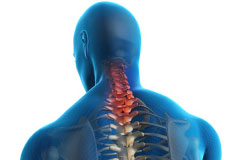
Neck Strains and Sprains
A strain refers to damage to the muscle or its tendon when it is stretched beyond its capacity. In severe cases, it may even result in a muscle tear.
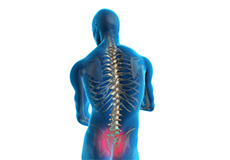
Sacroiliac Joint Dysfunction
Sacroiliac joint dysfunction or sacroiliac joint pain is one of the common causes of low back pain.


Scoliosis
Scoliosis is a condition characterized by the abnormal curvature of the spine that causes a deviation to one side. It causes a physical deformity, making the spine look like the letter “C” or “S” instead of the letter “I”. Scoliosis can affect either the mid or lower back. Scoliosis of the mid back is more common. Scoliosis can occur at any age.
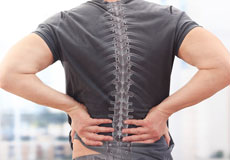
Spine Injuries in Athletes
Spine injuries in athletes are defined as damage sustained by the spine as a result of physical trauma or overuse in people who are actively involved in sports.
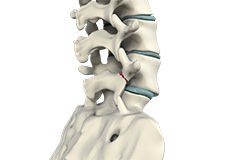
Spondylolysis
Spondylolysis is a stress fracture in the vertebra that may progress into spondylolisthesis, a condition where the vertebra gets displaced from the spinal column. Spondylolysis is the cause of frequent low back pain in children. It is more common among children and teenagers who participate actively in sports such as football, weightlifting, and gymnastics.

Whiplash
Whiplash is a soft tissue injury to the neck, usually caused by a sudden forceful jerk commonly occurring because of an automobile accident, sports injuries or an accidental fall. Headache may develop immediately or after a short period of time after the injury. Sometimes, whiplash may also be referred to as neck strain, neck sprain or hyperextension injury.
Spine Procedures
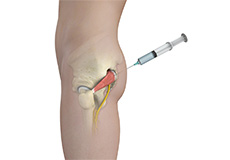
Piriformis Muscle Injection
A piriformis muscle injection is used to alleviate the spasm and pain of sciatica. The injection comprises an anaesthetic and steroid to reduce the spasm.
Useful Info
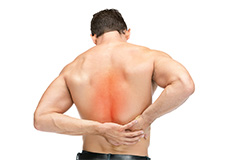
How to Prevent Back Pain
Back pain is common and usually affects everyone at some point. It often occurs more frequently as you grow older. Pain can either be sharp and sudden or dull and constant. Acute back pain lasts a few days or weeks while pain that lasts more than 6 months is considered chronic. Adopting a few good habits and taking certain precautions can help prevent back pain.
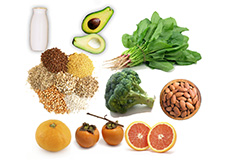
Nutrition and Your Spine
Nutrition refers to the entire cycle of chemical changes occurring within the body based on what we eat or don’t eat. It determines the strength of the teeth, bones and the connective tissues. A healthy diet during childhood paves the way for healthy adulthood.
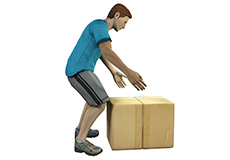
Proper Lifting
Lifting heavy weights and improper lifting of weights is one of the foremost causes of neck pain or lower back pain. Practicing proper lifting techniques is essential to avoid strain on your neck and back.


